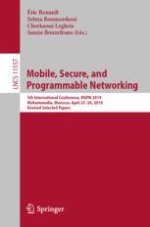2019 | Buch
Mobile, Secure, and Programmable Networking
5th International Conference, MSPN 2019, Mohammedia, Morocco, April 23–24, 2019, Revised Selected Papers
herausgegeben von: Éric Renault, Selma Boumerdassi, Cherkaoui Leghris, Samia Bouzefrane
Verlag: Springer International Publishing
Buchreihe : Lecture Notes in Computer Science
